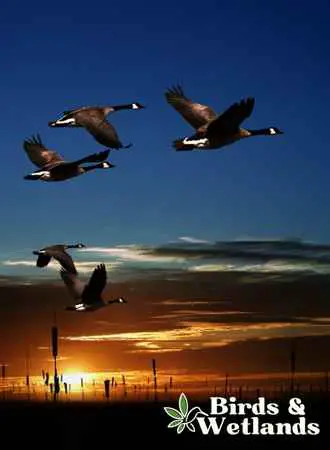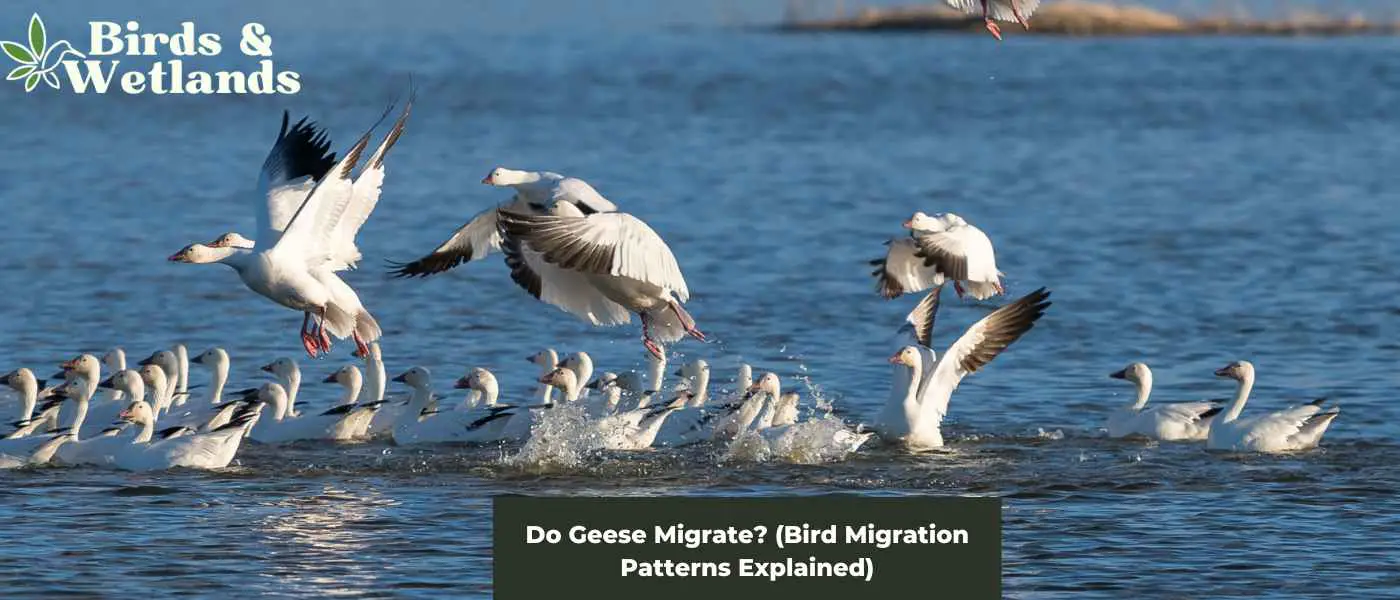Migration is a difficult and dangerous journey, but it is necessary for the species’ survival. Geese are one of many bird species that migrate.
For geese, migration is an instinct triggered by changes in the amount of daylight. As the days become shorter and the nights become longer, geese and other waterfowl of North America prepare for their journey south in the fall.
These birds will eat a lot of food to build up their fat reserves and may have regained new flight feathers after molting. When geese are ready to migrate, they travel in large flocks along migration routes called flyways.
Geese can access the food and resources they need to survive the cold months by wintering in warmer climates.
Migration is a difficult and dangerous journey, but it is necessary for the species’ survival. Geese are one of the billions of birds that migrate annually.
For geese, migration is an instinct triggered by changes in the amount of daylight and food availability.
As the days become shorter and the nights become longer, geese and other waterfowl of North America prepare for their journey south in the fall.
Most geese migrate twice a year, once in the fall and once in the spring.
Fall migration occurs between September and November when geese head south to temperate climates from their nesting sites in Northern Alaska, sub-Arctic regions, southwestern Ontario Maritime province and British Columbia in search of more abundant food sources.
Spring migration usually occurs between March and May, when they return to their northern nesting sites to mate and breed chicks.
Why do geese migrate?
Most geese, such as the Canada geese and snow geese tend to migrate twice a year. The fly south in the winter and then back north in the spring.
Fall migration occurs between September and November when geese migrate south from their breeding sites in the north in search of more abundant food sources. Many food sources freeze over or become snow-covered in the winter, making them inaccessible to birds. Birds can access the food they need by migrating to warmer climates.
Spring migration usually occurs between March and May, when geese migrate north from their wintering grounds to mate and breed. Their breeding sites are frequently free of predators and competition, making them ideal for raising chicks.
Like most birds, geese can take advantage of the best conditions for raising their young and finding food by spending the spring and summer in a cold region and the winter in a warm one.
Most geese typically travel in flocks during fall and spring migrations, flying in formation to conserve energy.
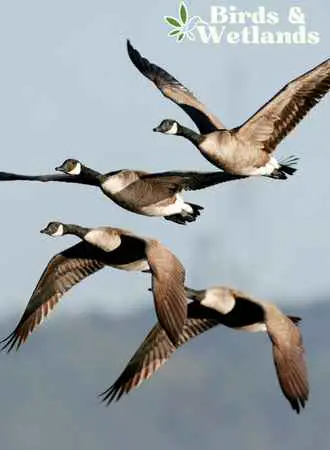
When do geese migrate?
Understanding Canada geese migration patterns can provide valuable insights into how these amazing birds adapt to changing seasons. Canada geese are one of North America’s most well-known migratory birds. These birds migrate annually between breeding and non-breeding sites, following a schedule dictated by the changing seasons.
Geese and other birds begin their migration south in the fall, typically leaving their breeding grounds in September or October. They will spend the winter at their non-breeding locations before returning north in the spring. The exact timing of the migration varies depending on the population, but most birds begin their journey north in April, May, or early June.
Adults become flightless for several weeks in late summer as they molt their wing feathers.
Where do the geese migrate?
Migratory geese migrate south during the winter to avoid the cold. They can be found in southern North America, where they spend the winter months huddled in groups. Then, as spring arrives and the weather begins to warm, they start their journey back to their northern breeding grounds. This journey can be long and difficult, but it is worthwhile for these birds.
Migrating Canada geese have areas where they live and breed and other areas where they go during the non-breeding season. They return to these same areas year after year.
Most flocks spend winters in the southern parts of the United States, while others migrate all the way to Central America.
Migration allows them to take advantage of the pleasant weather and plentiful food available in the north at this time of year.
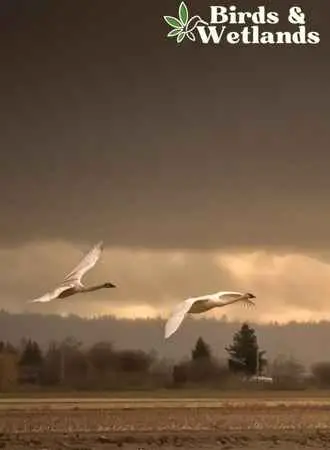
How long do geese fly without stopping?
Geese are amazing creatures, capable of flying for long periods of time without stopping. While they cannot fly the entire migration route in one go, they can often cover between 200 to 400 miles daily by making several stops along the way. But this depends on a lot of factors such as weather conditions.
Most geese species will only fly during the day, which helps to conserve their energy levels. Even so, flying for long periods can be fatiguing, and geese often take breaks to rest and refuel.
Do geese migrate at night?
Most birds migrate during the day, but geese have been observed flying at night. Several factors, weather and moonlight, determine the time of day they migrate. Geese migrate when the weather is cooler because the air is more stable and there is less wind. The increased stability allows them to fly longer distances.
Furthermore, flying at night can assist geese in avoiding predators and humans. When the conditions are favorable, geese can benefit from migrating at night. However, migration is a complex process, and geese must consider all available information before flying.
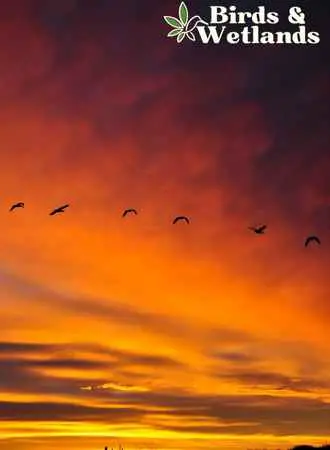
Why do some Canada geese not migrate?
Some Canadian geese have learned to take advantage of human resources, so they no longer migrate. Most of these geese have been born and raised in urban environments. Their parents most likely lost their migratory instincts and cannot pass them on to their young.
These water birds have discovered that their preferred food, grass and aquatic vegetation, are abundant at local parks, golf courses, lakeside yards, and residential lakes. Furthermore, these locations protect these vulnerable birds from predators.
As a result, these geese have decided to settle in temperate regions of North America, where they are year-round residents.
While this benefits the geese, it frequently causes human problems because these birds can become a nuisance.
How do geese know where to migrate?
In most cases, it comes down to experience. Young geese learn the migration routes and stopover sites used by their species for generations by following the lead of older, more experienced birds.
Landmarks also play a role in navigation, with birds orienting themselves using natural features (such as mountains and rivers) and man-made structures (such as power lines and roads). Many migrating geese head to the coast and then migrate south along the shoreline.
Furthermore, many birds use celestial cues such as the sun and stars to navigate. Many geese have an internal compass to detect and use the Earth’s magnetic field as a guide.
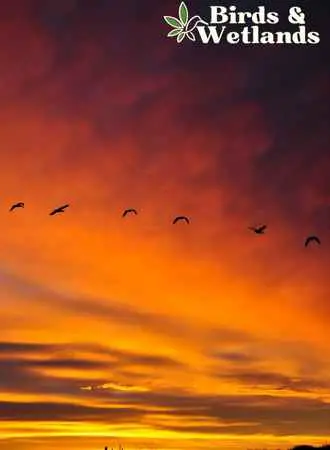
Do geese migrate in flocks?
Geese such as the Canada goose, snow goose, cackling goose, Ross’s goose and brent goose are gregarious birds and generally migrate in flocks. The exact size of the flock depends on the goose species, but many geese travel in groups of 10 to 30 birds.
Some geese migrate alone but often congregate with other geese at their stopover sites.
Flocks typically consist of family groups, with parents flying next to their young goslings. This gregarious behavior helps ensure the flock’s safety, as there is strength in numbers. Migrating in flocks makes finding food and navigating unfamiliar territory easier.
Do all geese fly in V formation during migration?
The V flying formation is the most aerodynamic way for birds to fly in a flock. The lead bird helps the birds behind it by breaking the wind and making it easier for them to fly. Each bird in the V-formation conserves energy by flying in the updraft created by the bird in front of it.
It is not surprising, then, that many geese, including the Greylag geese, migrate in the V-formation during their migration flights. The Canada goose is known for this iconic flight formation. However, there are a few exceptions, such as the brant or brent geese.
Brent geese migrate in family groups and fly with other flocks. They rarely fly in V formation. While the reasons for this are unknown, it is likely that because brant geese are a smaller species of goose, they use a different migration strategy.
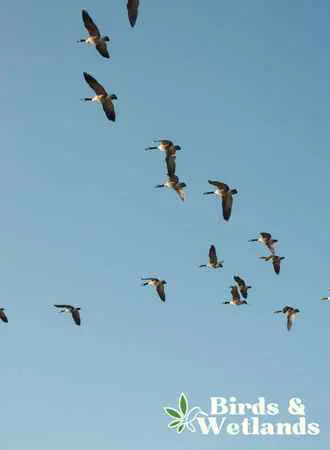
What are waterfowl flyways?
Waterfowl flyways are the migratory routes they take during their annual migration. There are four major flyways in North America — Pacific, Central, Mississippi and Atlantic.
The number and species of waterfowl that use each flyway vary. Where a goose species breeds determine which flyway it uses during migration.
The US Fish and Wildlife Service established the system in 1948, and the Flyway Councils now manage it. Each flyway has a Council, which consists of representatives from each state that is part of that flyway.
The flyway system aims to ensure that waterfowl have enough food and habitat in each region while providing opportunities for hunters to harvest ducks, geese, and swans.
Each flyway is divided into sub-regions, and each sub-region has a set number of hunting days. The estimated number of waterfowl in that area determines the number of days in the hunting season.
